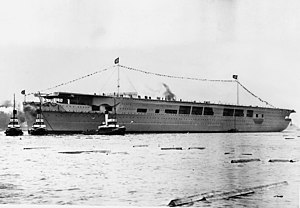German aircraft carrier Graf Zeppelin

Graf Zeppelin after her launching on 8 December 1938
|
|
| History | |
|---|---|
|
|
|
| Name: | Graf Zeppelin |
| Namesake: | Count Ferdinand von Zeppelin |
| Builder: | Deutsche Werke |
| Laid down: | 28 December 1936 |
| Launched: | 8 December 1938 |
| Fate: | Sunk as a target ship on 16 August 1947 |
| General characteristics | |
| Class and type: | Graf Zeppelin-class aircraft carrier |
| Displacement: | 33,550 long tons (34,088.4 t) |
| Length: | 262.5 m (861 ft 2.6 in) |
| Beam: | 36.2 m (118 ft 9.2 in) |
| Draft: | 8.5 m (27 ft 10.6 in) |
| Installed power: | 200,000 shaft horsepower (149,140.0 kW) |
| Propulsion: | 4 geared turbines |
| Speed: | 33.8 kn (62.6 km/h; 38.9 mph) |
| Range: | 8,000 nmi (14,816.0 km; 9,206.2 mi) at 19 kn (35.2 km/h; 21.9 mph) |
| Complement: | 1,720 |
| Armament: |
|
| Armor: |
|
| Aircraft carried: |
|
The German aircraft carrier Graf Zeppelin was the lead ship in a class of two carriers of the same name ordered by the Kriegsmarine. She was the only aircraft carrier launched by Germany and represented part of the Kriegsmarine's attempt to create a well-balanced oceangoing fleet, capable of projecting German naval power far beyond the narrow confines of the Baltic and North Seas. The carrier would have had a complement of 42 fighters and dive bombers.
Construction on Graf Zeppelin began on 28 December 1936, when her keel was laid down at the Deutsche Werke shipyard in Kiel. Named in honor of Graf (Count) Ferdinand von Zeppelin, the ship was launched on 8 December 1938, and was 85% complete by the outbreak of World War II in September 1939. Graf Zeppelin was not completed and was never operational due to shifting construction priorities necessitated by the war. She remained in the Baltic for the duration of the war; with Germany's defeat imminent, the ship's custodian crew scuttled her just outside Stettin in March 1945. The Soviet Union raised the ship in March 1946, and she was ultimately sunk in weapons tests north of Poland 17 months later. The wreck was discovered by a Polish survey ship in July 2006.
Graf Zeppelin was 262.5 meters (861.2 ft) long overall; she had a beam of 36.2 m (118.8 ft) and a maximum draft of 8.5 m (27.9 ft). At full combat load, she would have displaced 33,550 long tons (34,088.4 t). The ship's propulsion system consisted of four Brown, Boveri & Cie geared turbines with sixteen oil-fired, ultra-high-pressure LaMont boilers. The power plant was rated at 200,000 shaft horsepower (149,140.0 kW) and a top speed of 33.8 knots (62.6 km/h; 38.9 mph). Graf Zeppelin had a projected cruising radius of 8,000 nautical miles (14,816.0 km; 9,206.2 mi) at a speed of 19 kn (35.2 km/h; 21.9 mph). She would have had a crew of 1760 officers and enlisted men, plus flight crews.
...
Wikipedia
